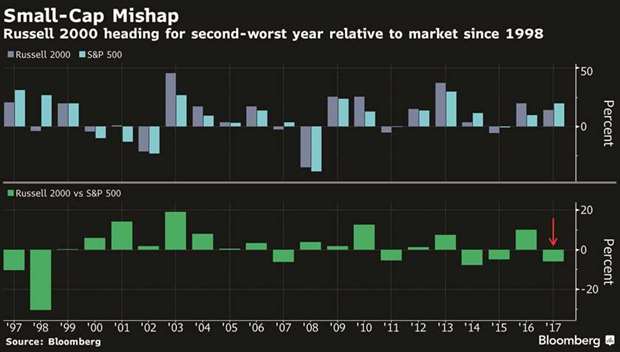Of all the investing themes that were supposed to go smoothly in the year of a landmark tax cut, owning US small caps looked like the closest thing to a slam dunk. It hasn’t played out that way.
Sure, the group is up.
The Russell 2000 has risen 14% in 2017 and may end up posting positive returns in nine out of 12 months, including a 6.1% advance in October. But in a year when the Nasdaq 100 has rallied 33% and even value stocks posted double-digit gains, bulls could be forgiven for wanting more.
For December, the Russell 2000 is down 0.1%, compared with advances of 1.4% for the S&P 500 and 1.6% for the Nasdaq 100.
At risk of a down year as recently as August 21, the small-cap index climbed 14% through the end of November and has been treading water ever since.
“Mr Market has a habit of knowing things none of us mere mortals know,” Dan Veru, chief investment officer of Palisade Capital Management at Fort Lee, New Jersey, said by phone. “There was tremendous optimism that the tax reform was going to sail through, and then the reality of governing came into play and the Russell went sideways.” All year, stars have seemed to align for the smallest publicly traded companies. The dollar was down, economic growth exceeded 3%. With an effective tax rate that is 10% higher than the rest of the market, President Donald Trump’s domestic-focused growth policies looked poised to do at least as much for smaller firms as they did for the S&P 500.
Instead, the group has been bedeviled by twists and turns that were absent elsewhere. In a year when the S&P 500 has never once declined 3% from any past high, the Russell 2000 has endured two drops of close to 5% and one exceeding 6%.
The group has posted single-day gains or losses of more than 1% five times in the last month, something the S&P 500 hasn’t done once since September.
On Wall Street, they’re groping for explanations. Bank of America equity strategist Savita Subramanian floated a theory that pertains to the choices companies face for how to use extra cash.
When a company is handed a pile of money through a tax cut, it can hoard it, give it to shareholders, or plow it into new equipment, she notes. But there’s something else that represents less of a direct benefit to the equity side: pass it along to customers.
Smaller firms with less pricing power may turn to the strategy the most, Subramanian says.
“Small caps are seen as the biggest beneficiaries of tax reform given their higher tax rates, but a lasting impact is harder to justify as a large portion of the benefit would likely be competed away,” Subramanian wrote in a December 20 note to clients.
The firm’s data show that small-cap companies in the Russell 2000 have an effective tax rate of 29.7%, compared with 26.9% in the S&P 500.
Goldman Sachs says investors may have had too uniform a view on the group and the implications of tax policy for its bottom line.
“Although small-caps tend to pay higher effective tax rates and are typically more domestic-facing than large-caps, the Russell 2000 has been hampered by the risk posed by limiting interest rate deductibility as well as the fact that nearly one-third of index constituents have zero or negative pretax income,” strategists including Ben Snider and David Kostin wrote in a December 21 note.
They “therefore would reap little benefit from the interest rate cut.”

.


